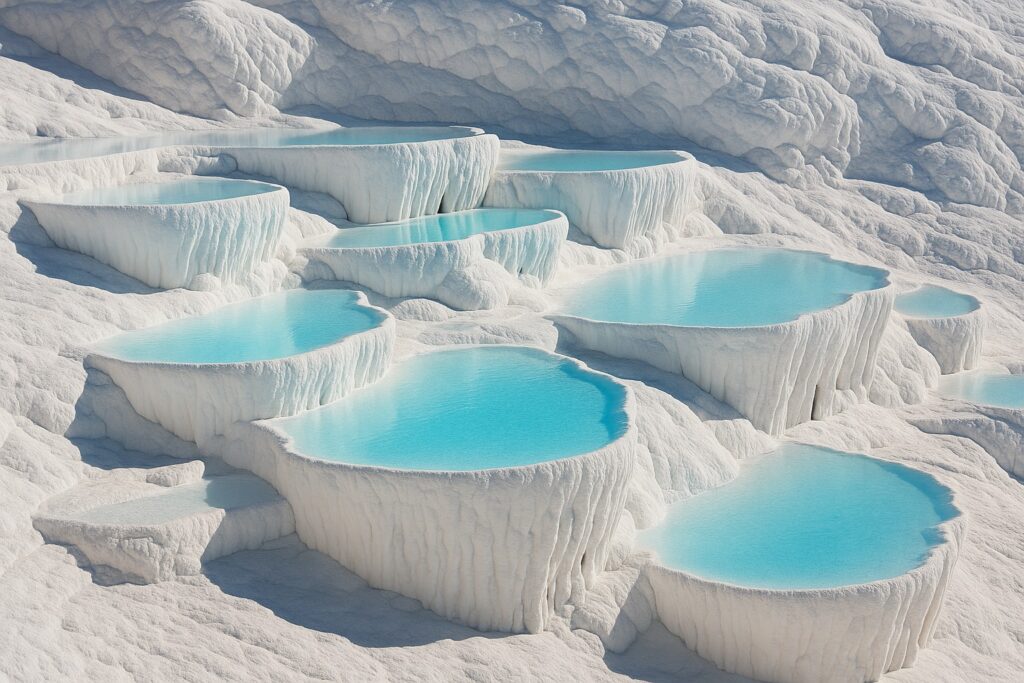Perched above the town of Denizli in southwestern Turkey, Pamukkale (meaning “cotton castle” in Turkish) is one of the world’s most surreal and beautiful natural wonders.
Lees verder: Discover Pamukkale: Turkey’s Otherworldly Cotton Castlets dazzling white terraces, formed by calcium-rich hot springs cascading down the mountainside, look like a frozen waterfall or a landscape from another planet. Visitors have marveled at Pamukkale’s ethereal beauty for millennia, and today it’s a UNESCO World Heritage Site that attracts travelers from every corner of the globe.
This ultimate 2025 guide will give you everything you need to plan your trip to Pamukkale, including how to get there, what to do, the history behind the site, and tips for an unforgettable experience.
What is Pamukkale?
Pamukkale’s terraces are formed from travertine, a type of limestone deposited by the region’s natural hot springs. Over thousands of years, mineral-rich waters flowing down the hillside have created a series of white terraces and turquoise pools, resulting in the cotton-like appearance that gives Pamukkale its name.
Temperatures in the thermal waters average 35–36°C (95–97°F), making them perfect for a relaxing soak. But Pamukkale isn’t just a natural wonder — it’s also home to the ancient Greco-Roman city of Hierapolis, which was founded around the 2nd century BCE and became famous for its healing hot springs.
The History of Pamukkale and Hierapolis
Long before Instagram made it famous, Pamukkale was revered by ancient civilizations. Hierapolis was established by the Attalid kings of Pergamon, and later flourished under Roman rule as a spa city. Wealthy Romans traveled from across the empire to bathe in its mineral waters, believing they had healing properties.
Over centuries, earthquakes destroyed and rebuilt Hierapolis many times, but impressive ruins remain: a large necropolis, Roman baths, temples, a basilica, and one of the best-preserved ancient theaters in Turkey.
In 1988, Pamukkale-Hierapolis was declared a UNESCO World Heritage Site for its unique combination of natural and cultural significance.
Where is Pamukkale?
Pamukkale is in Denizli Province, southwestern Turkey, about:
- 20 minutes from Denizli city center.
- 3 hours from Izmir.
- 4 hours from Antalya.
- 7 hours from Istanbul by car.
The closest airport is Denizli Çardak Airport (DNZ), which has daily flights from Istanbul.
How to Get to Pamukkale



When to Visit Pamukkale
Pamukkale is beautiful year-round, but your experience will vary depending on the season:




Visiting Pamukkale’s Terraces
Access to the terraces is regulated to protect this fragile natural wonder. Visitors must:



Entrance Fees & Opening Hours (2025)


There are three entrances:



Hierapolis Ancient City Highlights
Visiting Pamukkale isn’t complete without exploring Hierapolis:




Swimming in Cleopatra’s Pool
One of Pamukkale’s most unique experiences is Cleopatra’s Pool (Antique Pool), a hot spring pool with submerged ancient columns — legend says Cleopatra herself swam here.
- Water temperature: ~36°C (97°F).
- Entrance fee: 300–400 TL extra ($10–15 USD).
- Facilities: changing rooms, lockers, café.
- It’s open all year — perfect for a warm soak even in winter.
Best Things to Do in Pamukkale

Take your time to stroll barefoot along the pathways, marvel at the milky-blue pools, and enjoy views over the valley.

Relax among ancient ruins in warm, mineral-rich waters.

Wander the ancient streets, theater, necropolis, and learn about the city’s fascinating history.

For adrenaline junkies: fly over the terraces and ruins with incredible aerial views.

A sunrise balloon flight offers a unique perspective of the cotton-white landscape.
Photography Tips for Pamukkale



Tips for Visiting Pamukkale





Where to Stay Near Pamukkale



What to Eat in Pamukkale

Day Trips from Pamukkale
Pamukkale makes a great base for exploring other fascinating sites in southwestern Turkey:
- Laodicea: Ancient city with impressive columns, only 10 km away.
- Aphrodisias: A beautifully preserved Greco-Roman city dedicated to Aphrodite, ~90 minutes by car.
- Salda Lake: Known as “Turkey’s Maldives” for its white sand and turquoise water, ~2 hours away.
Sustainable Travel in Pamukkale
Pamukkale has suffered from overtourism in the past, so it’s important to visit responsibly:



Frequently Asked Questions
Can you swim in the terraces themselves?
Only in small designated pools. Swimming in the large travertine basins is prohibited to prevent damage.
Do you need a guide?
Not mandatory, but a local guide can enrich your visit with stories about Hierapolis and the travertines.
Is Pamukkale worth visiting?
Absolutely! It’s one of Turkey’s most unique destinations — a combination of natural wonder and ancient history you won’t find anywhere else.
Final Thoughts: Pamukkale is Turkey’s Unmissable Wonder
From ancient healing waters to otherworldly white terraces, Pamukkale is a destination like no other. Whether you’re soaking in Cleopatra’s Pool, walking barefoot along the dazzling formations, or exploring the ruins of Hierapolis, this place will leave you in awe.
If you’re planning a trip to Turkey, make sure Pamukkale is at the top of your bucket list — it’s a journey through time, nature, and the power of thermal waters that have inspired visitors for thousands of years.




